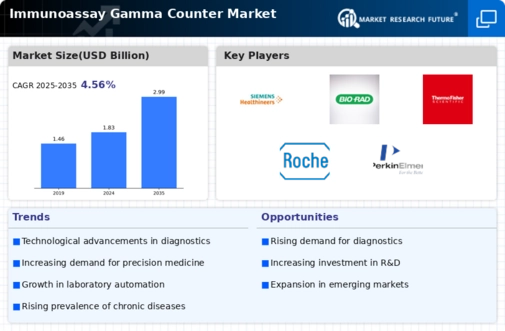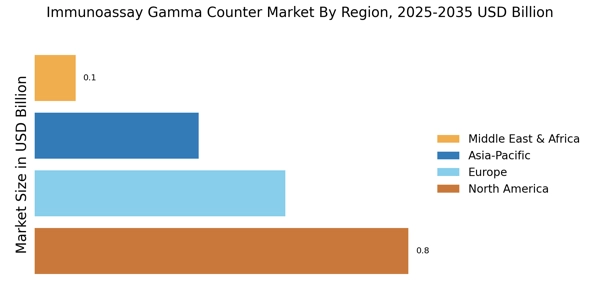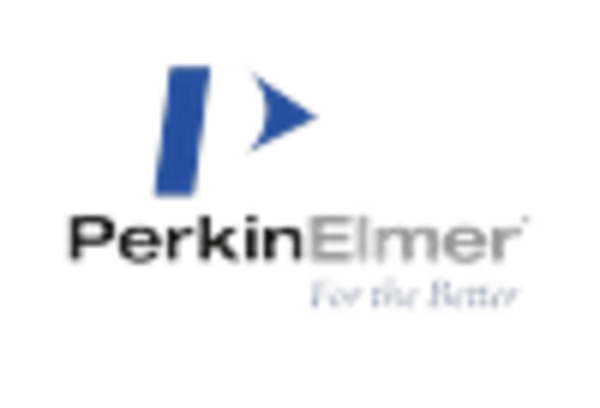Rising Prevalence of Chronic Diseases
The increasing prevalence of chronic diseases such as diabetes, cancer, and cardiovascular disorders is a primary driver for the Immunoassay Gamma Counter Market. As these conditions require regular monitoring and precise diagnostics, the demand for advanced immunoassay technologies is likely to rise. According to recent data, chronic diseases account for a significant portion of healthcare expenditures, prompting healthcare providers to invest in efficient diagnostic tools. The Immunoassay Gamma Counter Market is positioned to benefit from this trend, as these counters facilitate rapid and accurate testing, thereby improving patient outcomes and reducing long-term healthcare costs. This growing need for effective disease management solutions is expected to propel the market forward.
Growing Focus on Preventive Healthcare
The growing emphasis on preventive healthcare is emerging as a significant driver for the Immunoassay Gamma Counter Market. As healthcare systems shift towards preventive measures, the demand for early detection of diseases is increasing. Immunoassay gamma counters play a crucial role in screening and monitoring patients, enabling timely interventions. This shift is supported by various health initiatives aimed at reducing the burden of diseases through early diagnosis. Market analysis suggests that investments in preventive healthcare are likely to rise, further boosting the demand for immunoassay technologies. The Immunoassay Gamma Counter Market stands to gain from this trend, as healthcare providers seek reliable tools for effective disease prevention.
Increased Research and Development Activities
Increased research and development activities in the field of diagnostics are driving growth in the Immunoassay Gamma Counter Market. As researchers seek to develop novel assays and improve existing technologies, the demand for advanced gamma counters is likely to rise. Funding from both public and private sectors for biomedical research is on the rise, facilitating innovation in diagnostic tools. This trend is expected to lead to the introduction of more sophisticated immunoassays, which could enhance the capabilities of gamma counters. Consequently, the Immunoassay Gamma Counter Market may experience growth as new products emerge from ongoing research efforts, catering to the evolving needs of healthcare providers.
Regulatory Support for Diagnostic Innovations
Regulatory support for innovations in diagnostic technologies is a crucial driver for the Immunoassay Gamma Counter Market. Regulatory bodies are increasingly recognizing the importance of advanced diagnostic tools in improving patient care. Streamlined approval processes for new immunoassays and gamma counters are likely to encourage manufacturers to invest in research and development. This supportive regulatory environment can lead to a faster introduction of innovative products into the market, thereby enhancing competition and driving growth. As a result, the Immunoassay Gamma Counter Market is expected to benefit from these favorable regulations, which promote the development of cutting-edge diagnostic solutions.
Technological Innovations in Diagnostic Tools
Technological advancements in diagnostic tools are significantly influencing the Immunoassay Gamma Counter Market. Innovations such as enhanced sensitivity, automation, and integration with laboratory information systems are making these counters more efficient and user-friendly. The introduction of next-generation immunoassays, which offer improved accuracy and faster results, is likely to attract more healthcare facilities to adopt these technologies. Market data indicates that the demand for automated systems is on the rise, as they reduce human error and increase throughput. Consequently, the Immunoassay Gamma Counter Market is expected to experience growth driven by these technological improvements, which enhance the overall diagnostic process.


















Leave a Comment